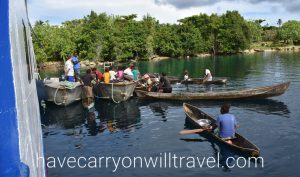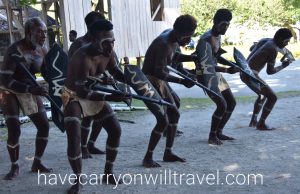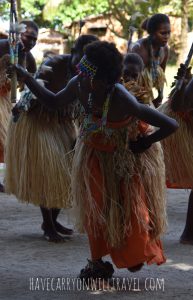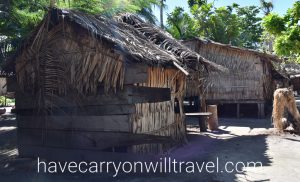During our cruise around the Solomon on Islands on the Bilikiki, we encounter many of the local people. Every time we moor in a quiet bay near an island, villagers paddle out in their hand made canoes to sell pineapples, papaya, bananas, eggplant, callaloo, sweet potato, limes, squash and onion. The villagers are very friendly and always have a “Hello” ready. I wonder what they think of us on the boat, spending time under the water looking at fish.
We stop at three villages on separate islands to shop. They gather just for the Bilikiki. The villagers are craftsmen who carve (mostly), weave and paint. All the sellers have set up tables or blankets to show their wares and the rest of the villagers stand back to watch the excitement. The sellers are shy but once we initiate a conversation, they are very happy to chat with us. One fellow tells me he was born in 1949 and has three girls, all in their teenage years. He is worried that his English is not good, but I assure him that it is just fine and he is pleased. We get interrupted by one of our fellow divers wanting to purchase a wooden carving.
Our next village visit is to Karumolun to enjoy some local singing and dancing. Murray is not feeling well, so I abscond with his camera and join the group boating over to the small island. We are greeted by the chief, who shakes our hands and welcomes us. We are then given flower leis that the children have made and I end up with two, mine and Murray’s.
We take a seat on benches and the men appear in loin cloths, white body paint, shields and spears (decorative only). They sing in their language, with harmonies and bass, and it is mesmerizing. I close my eyes briefly and loose myself in the music.
Next are the women, dressed in cloth dresses with grass skirts over top, some wearing beaded headdresses and necklaces. They are shy and do not make eye contact with the watchers. It is cute watching the children of the women on the sidelines wanting to go to Mom, but knowing that they cannot. They sing and dance as a group with repetitive steps and movements. It is also musical, but for my ears, not as mesmerizing as the men. The dancing involves a thump on the ground with the ball of the foot, which provides the “drumbeat”.
The next section is fascinating and I now wish Murray was here to hear. The villagers have made various pan pipe type instruments out of PVC pipe. The largest instrument has about 15 different lengths of pipe all in a row, which would play the lead. There are about 4 instruments that have 4 groups of 3 pipes tied together and all different lengths. These provide the “chords”, and include minor chords. All these instruments are played with cut down flip flops and make a hollow thup sound.
There are 3 fellows playing huge pipe instruments by blowing into them, that are the bass and a fellow playing a skin drum.
The music they produce is fantastic with a unique sound. The women join in to sing along for a song, allowing the children to join in and dance and sway.
We wander the village with the chief as our guide. This village is well kept with a central area housing a school and church. The houses surround the area and are built with two buildings, a kitchen and a sleeping house. They are tidy outside with well maintained exteriors. Oli, one of our dive directors, tells me that the chief and his commitment have a lot of say in how a village is run and this village is being run extremely well.




